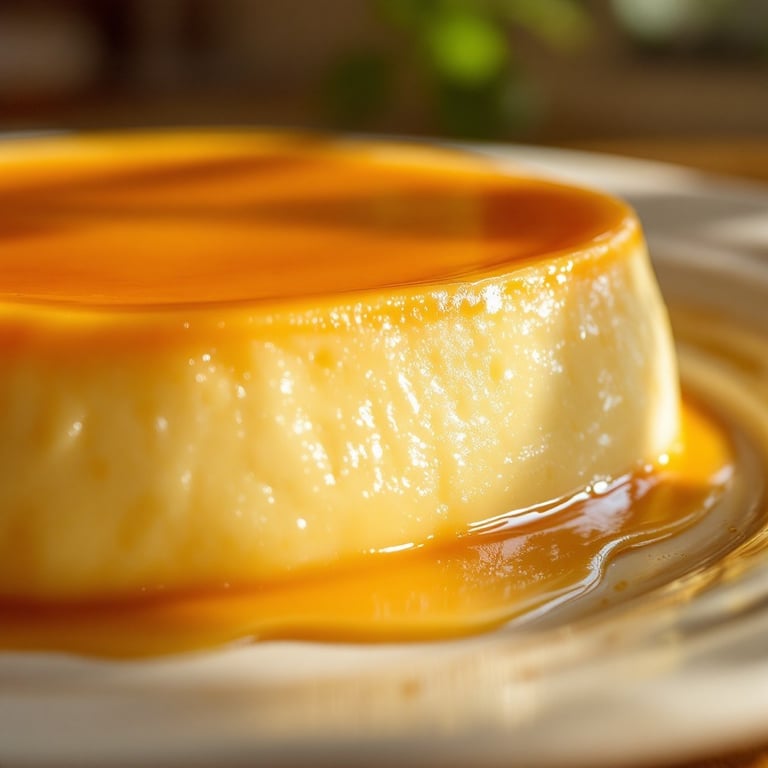Cream Cheese Flan
Flan, also known as caramel custard, has roots in both ancient Rome and Spain.
DESSERT
Lourdes Rodriguez
2/23/20255 min read


History of Flan
Flan, also known as caramel custard, has roots in both ancient Rome and Spain. Roman documents mention custard recipes after they began to domesticate chickens and had easy access to eggs. They called their custard, tyropatina. Their recipe uses eggs, milk, and honey, often flavored with spices like bay leaves. The dessert has evolved over centuries, influenced by various cultures.
The word "flan" is derived from the Latin word flado, which means "flat cake." Spain is credited with modernizing flan, turning it into the smooth, creamy dessert we recognize today. During the Middle Ages, the Spanish added sugar and caramelized it to form the rich golden topping. As the Spanish Empire expanded to the Americas in the 16th century, the dessert spread throughout Latin America.
In many Latin American countries, flan is a beloved dessert, often served during special occasions or family gatherings. The custard dessert was also adapted to include various regional ingredients, such as coconut, vanilla, chocolate, and even coffee.
Countries that Eat Flan
Flan is popular in many parts of the world, especially in Latin America, Spain, and parts of Asia. Some of the countries where flan is a traditional dessert include:
Spain: Known as "flan de huevo" (egg flan).
Mexico: Often flavored with vanilla or cinnamon and served as "flan napolitano."
Cuba: Known for its smooth texture, sometimes called "flan de leche."
Puerto Rico: Known as “flan de queso” has a velvety texture.
Argentina, Venezuela, and other South American countries: Flan is a classic dessert, sometimes served with dulce de leche (caramelized milk).
Philippines: In the Philippines, flan is also known as "leche flan," a rich and thick custard often served during celebrations.
Tips to make the perfect cream cheese flan
It requires a balance of smooth texture, rich flavor, and a perfectly caramelized top.
Perfecting the Caramel
Use granulated sugar to get a deep amber caramel.
Melt sugar over medium-low heat, swirling the pan occasionally to prevent burning.
Once golden, immediately pour it into the flan mold and tilt to coat the bottom evenly before it hardens.
Smooth & Creamy Custard
Use room-temperature cream cheese for a lump-free batter.
Blend all ingredients (cream cheese, eggs, condensed milk, evaporated milk, vanilla) until completely smooth. Strain the mixture to remove air bubbles and ensure a silky texture.
Avoid overmixing; too much air can create holes in the flan.
Baking it Just Right
Bake in a bain-marie (water bath) to ensure even cooking and prevent cracks. Place the flan mold inside a larger baking dish filled with hot water (about halfway up the sides of the mold). Bain-Marie is a cooking technique use to cook delicate food like custards, terrines and melt chocolate. Its purpose is to create a gentle heat around the food.
Bake at 350°F (175°C) for about 50-60 minutes or until the center jiggles slightly when shaken.
The Cooling & Unmolding Process
Let the flan cool to room temperature, then refrigerate for at least 4 hours (preferably overnight) for the best texture.
To release, run a knife around the edges, then place a serving plate on top and flip quickly. The caramel will flow beautifully over the flan.
Recipe for Cream Cheese Flan
Yield: 8-10 servings
Ingredients:
For the caramel:
1 cup sugar
2 tbsp water
For the flan:
5 large whole eggs
1/2 cup sweetened condensed milk
1 cup evaporated milk
8 oz. package of Cream Cheese
Instructions:
Prepare the caramel: In a medium saucepan over medium heat, combine sugar and water. Stir occasionally until the sugar melts and turns a golden amber color. Be careful not to burn it. Quickly pour the caramel into a round 8-inch cake pan (ensure the sides are coated with the caramel). Swirl the pan to coat the bottom evenly. Let it sit while you prepare the flan.
Make the cream cheese flan: In a blender, combine cream cheese, sweetened condensed milk, evaporated milk, eggs, vanilla extract, and a pinch of salt. Blend until smooth and well combined.
Bake the flan: Preheat your oven to 350°F (175°C). Pour the flan mixture over the caramel in the prepared pan. Place the flan pan inside a larger roasting pan. Fill the roasting pan with hot water halfway up the sides of the flan pan to create a water bath (best known as “Bain Marie”). Bake for 50-60 minutes, or until a toothpick inserted into the center comes out clean. The flan should be set but slightly jiggly in the middle.
Cool and Serve: Let the flan cool at room temperature for about an hour, then refrigerate for at least 4 hours or overnight. To serve, run a knife around the edges of the pan to loosen the flan. Invert onto a plate, and drizzle the caramel sauce over the top.
Note:
Microwave caramel:
1 cup sugar
½ cup water
Microwave Safe, Pyrex, Glass Measuring Cup (2 cups minimum size)
Instructions:
In a microwave safe, Pyrex, glass measuring cup, microwave 1 cup of sugar and the ½ cup of water, for 5 minutes. The caramel should look light amber. With a heat proof mitten, grab the caramel and place it carefully over 8-inches round metal cake pan
If the caramel hardens while you add the cream cheese filling, do not worry it will liquify back into the oven.
Serving Suggestions
Serve cold: Flan is best served chilled, as the cold enhances its creamy texture.
Garnish with whipped cream: Add a dollop of freshly whipped cream or a sprinkle of cinnamon for extra flavor.
Top with fruit: Consider fresh berries (strawberries, blueberries) or tropical fruits like mangoes or kiwi for a refreshing contrast.
Pair with coffee: Flan pairs wonderfully with a cup of espresso or a smooth latte. It makes for a perfect end to a meal or afternoon treat.
Flan is a versatile dessert that can be enjoyed on its own or with various toppings depending on your preference!
Reasons to Limit or Avoid Cream Cheese Flan
Here are some groups who should be cautious:
Lactose Intolerant Individuals - Flan contains cream cheese, evaporated milk, and condensed milk, which are high in lactose. Those with lactose intolerance may experience bloating, cramps, or digestive issues.
People with Dairy Allergies - A true dairy allergy can cause severe reactions, including hives, swelling, or anaphylaxis. These individuals should avoid flan entirely.
Those with Diabetes or Blood Sugar Issues - Flan is high in sugar due to caramel and sweetened condensed milk, which can spike blood sugar levels. People with diabetes should consume it in moderation or opt for a lower-sugar version.
Individuals with High Cholesterol or Heart Disease - The dessert is rich in saturated fats and cholesterol from cream cheese and eggs. Excessive consumption may not be ideal for those managing heart health.
People Watching Their Caloric Intake - Cream cheese flan is calorie-dense, so those on a strict diet may want to enjoy it sparingly or look for a lighter alternative.
Those with Egg Allergies - Eggs are a key ingredient in flan, making it unsuitable for people with egg allergies.
For anyone with dietary restrictions, dairy-free, sugar-free, or lower-fat alternatives can be made using substitutes like plant-based milk, low-fat cream cheese, or sugar alternatives.
Important: If you have any questions about how to incorporate this food into your diet, it's always a good idea to consult with your dietitian or doctor.
Plenitaste
Inspiring healthy, global recipes for everyone.
contact me:
Recipe
plenitaste@gmail.com
© 2025. All rights reserved.
